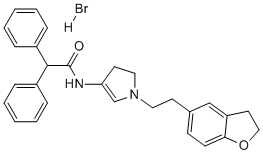
Darifenacin is a selective M3 muscarinic receptor antagonist with pKi of 8.9. Darifenacin produces a concentration dependent increase in R123 (P-gp probe) accumulation in MDCK cells. Darifenacin stimulates ATPase activity in P-gp membrane in a clear concentration dependent response manner with an estimated ED50 value of 1.6 µM. Darifenacin (100 nM) shows a significantly greater permeability for darifenacin in the basolateral to apical direction resulting in an efflux ratio in BBMEC monolayers of approximately 2.6.
In vivo Darifenacin produces dose-dependent inhibition of amplitude of volume-induced bladder contractions(VIBCAMP), producing 35% inhibition at dose of 283.3 nmol/kg and maximal inhibition of approximately 50-55%. Darifenacin (0.1 mg/kg i.v.) reduces bladder afferent activity in both Aδ and C fibers in female Sprague-Dawley rats, the decrease in afferent spikes in C fibers may be more pronounced than that in Aδ fibers.
| Molecular Weight | 507.46 |
| Formula | C28H30N2O2.HBr |
| CAS Number | 133099-07-7 |
| Solubility (25°C) | DMSO 70 mg/mL |
| Storage |
Powder -20°C 3 years ; 4°C 2 years In solvent -80°C 6 months ; -20°C 1 month |
| Species | Mouse | Rat | Rabbit | Guinea pig | Hamster | Dog |
| Weight (kg) | 0.02 | 0.15 | 1.8 | 0.4 | 0.08 | 10 |
| Body Surface Area (m2) | 0.007 | 0.025 | 0.15 | 0.05 | 0.02 | 0.5 |
| Km factor | 3 | 6 | 12 | 8 | 5 | 20 |
| Animal A (mg/kg) = Animal B (mg/kg) multiplied by | Animal B Km |
| Animal A Km |
For example, to modify the dose of Compound A used for a mouse (20 mg/kg) to a dose based on the BSA for a rat, multiply 20 mg/kg by the Km factor for a mouse and then divide by the Km factor for a rat. This calculation results in a rat equivalent dose for Compound A of 10 mg/kg.
[1] No authors listed. Darifenacin
[3] Andrej Skerjanec. The clinical pharmacokinetics of darifenacin
[4] Francois Haab. Darifenacin in the treatment of overactive bladder
| Related AChR/AChE Products |
|---|
| Tacrine
Tacrine is a potent acetylcholinesterse (AChE) inhibitor (IC50=109 nM), also acting as a CYP1A2 substrate agent. |
| THRX-160209
THRX-160209 is a potent antagonist at the M(2) muscarinic acetylcholine (ACh) receptor subtype that was designed using a multivalent strategy, simultaneously targeting the orthosteric site and a nearby site known to bind allosteric ligands. |
| Catestatin
Catestatin is a 21-amino acid residue, cationic and hydrophobic peptide. |
| α-Conotoxin MII
α-Conotoxin MII (α-CTxMII), a 16-amino acid peptide from the venom of the marine snail Conus magus, potently blocks nicotinic acetylcholine receptors (nAChRs) composed of α3β2 subunits, with an IC50 of 0.5 nM. |
| COG 133 TFA
COG 133 TFA is a fragment of Apolipoprotein E (APOE) peptide. |


Products are for research use only. Not for human use. We do not sell to patients.
© Copyright 2010-2023 AbMole BioScience. All Rights Reserved.
